 I thought I might turn up a parade or two when I went looking for Veteran’s Day events but I found not a one anywhere nearby. What I did find was a concert in a building that seems almost made for the occasional and that I’ve been curious about for some time. On the afternoon before Veteran’s Day, I headed downtown for the Veterans Salute at the Hamilton County Memorial Building.
I thought I might turn up a parade or two when I went looking for Veteran’s Day events but I found not a one anywhere nearby. What I did find was a concert in a building that seems almost made for the occasional and that I’ve been curious about for some time. On the afternoon before Veteran’s Day, I headed downtown for the Veterans Salute at the Hamilton County Memorial Building.
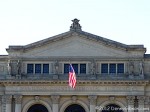 The building, commonly called simply Memorial Hall, was erected in 1908 as something of a joint venture between the county and the Grand Army of the Republic (GAR). It was designed by noted architect Samuel Hannaford. Hannaford designed many buildings in Cincinnati including the nearby Music Hall which tends to overshadow Memorial Hall. Even when the building is noticed, it is easy to miss the six Clement J. Barnhorn statues high above the entrance. Representing each of the nations’s conflicts at the time of construction, they are a soldier from the Revolution with a frontiersman from the Indian conflicts here, a sailor from the War of 1812 here, an artilleryman from the Mexican-American War here, and an infantryman from the Civil War with a “Rough Rider” sort of fellow from the Spanish-American War here.
The building, commonly called simply Memorial Hall, was erected in 1908 as something of a joint venture between the county and the Grand Army of the Republic (GAR). It was designed by noted architect Samuel Hannaford. Hannaford designed many buildings in Cincinnati including the nearby Music Hall which tends to overshadow Memorial Hall. Even when the building is noticed, it is easy to miss the six Clement J. Barnhorn statues high above the entrance. Representing each of the nations’s conflicts at the time of construction, they are a soldier from the Revolution with a frontiersman from the Indian conflicts here, a sailor from the War of 1812 here, an artilleryman from the Mexican-American War here, and an infantryman from the Civil War with a “Rough Rider” sort of fellow from the Spanish-American War here.
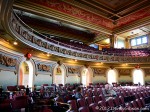
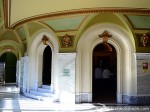
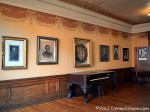 The doors opened in time for me to do a little exploring before the concert and that’s just what I did. Although most of the artifacts from the building’s GAR days are gone, many pictures remain. The wreath in the first photo is believed to have been at Lincoln’s funeral. There is lots of marble in the building. The marble arches in the second photo are entrances to the somewhat circular auditorium. After the concert, a pair of fellows from American Legacy Tours led a tour of the building which included the area above and behind the stage. Many of the men who constructed the building were craftsmen from the surrounding area and many of those were Civil War veterans. As the guides pointed out, it would be almost impossible to recreate this building, with extensive hand work like the GAR motto on the proscenium arch, today. Plus a much wider building would be required to hold the additional statues out front.
The doors opened in time for me to do a little exploring before the concert and that’s just what I did. Although most of the artifacts from the building’s GAR days are gone, many pictures remain. The wreath in the first photo is believed to have been at Lincoln’s funeral. There is lots of marble in the building. The marble arches in the second photo are entrances to the somewhat circular auditorium. After the concert, a pair of fellows from American Legacy Tours led a tour of the building which included the area above and behind the stage. Many of the men who constructed the building were craftsmen from the surrounding area and many of those were Civil War veterans. As the guides pointed out, it would be almost impossible to recreate this building, with extensive hand work like the GAR motto on the proscenium arch, today. Plus a much wider building would be required to hold the additional statues out front.
 At the start of the concert, I had one miss and a near miss. I was in the balcony so as to get a clear view of the stage and that turned out to be a not so good spot to photograph the Xavier University Honor Guard as they brought in the US and Ohio flags. It did turn out to be a good spot to photograph the Cincinnati Boychoir but I almost blew that. I had not studied the program and expected them to perform at least a few songs. I stood in my spot as they sang the national anthem intending to get a picture from a better location later. Fortunately I grabbed this not so great shot during The Star Spangled Banner since that would be all they sang. It was beautiful.
At the start of the concert, I had one miss and a near miss. I was in the balcony so as to get a clear view of the stage and that turned out to be a not so good spot to photograph the Xavier University Honor Guard as they brought in the US and Ohio flags. It did turn out to be a good spot to photograph the Cincinnati Boychoir but I almost blew that. I had not studied the program and expected them to perform at least a few songs. I stood in my spot as they sang the national anthem intending to get a picture from a better location later. Fortunately I grabbed this not so great shot during The Star Spangled Banner since that would be all they sang. It was beautiful.
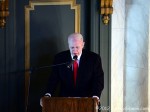
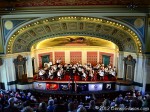 The actual concert was in the capable hands of the Queen City Concert Band with a short speech from retired USAF Captain and all around Cincinnati arts benefactor Otto M Budig, Jr, in the middle. Beginning with the ultra-appropriate Battle Hymn of the Republic, the band performed marches and hymns and a few things in between. I particularly liked the collection of mid-nineteenth century tunes called American Civil War Fantasy and The Armed Forces Salute medley gave veterans an opportunity to stand and be applauded and maybe do a little singing.
The actual concert was in the capable hands of the Queen City Concert Band with a short speech from retired USAF Captain and all around Cincinnati arts benefactor Otto M Budig, Jr, in the middle. Beginning with the ultra-appropriate Battle Hymn of the Republic, the band performed marches and hymns and a few things in between. I particularly liked the collection of mid-nineteenth century tunes called American Civil War Fantasy and The Armed Forces Salute medley gave veterans an opportunity to stand and be applauded and maybe do a little singing.
 John Philip Sousa is among the many musicians who have performed in this building during its long life. A couple of his marches were played here today with Stars and Stripes Forever as the stirring finale. US flags, given to attendees on entry, were waving throughout.
John Philip Sousa is among the many musicians who have performed in this building during its long life. A couple of his marches were played here today with Stars and Stripes Forever as the stirring finale. US flags, given to attendees on entry, were waving throughout.
The concert, presented by the Cincinnati Memorial Hall Society, was free. So was the punch and cookie reception provided by Fantasy in Frosting, portraits of veterans by Christopher Lowry, and the previously mentioned tour by American Legacy Tours.
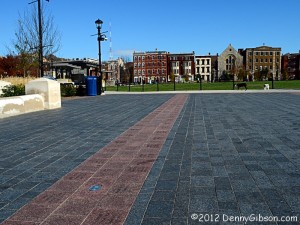 The Hamilton County Memorial Building houses the American Classical Music Hall of Fame but its modest exhibits were removed today to make room for cookies and cookie eaters. However, just across the street in Washington Park, the associated American Classical Music Walk of Fame is always available. Engraved bricks identify inductees.
The Hamilton County Memorial Building houses the American Classical Music Hall of Fame but its modest exhibits were removed today to make room for cookies and cookie eaters. However, just across the street in Washington Park, the associated American Classical Music Walk of Fame is always available. Engraved bricks identify inductees.
